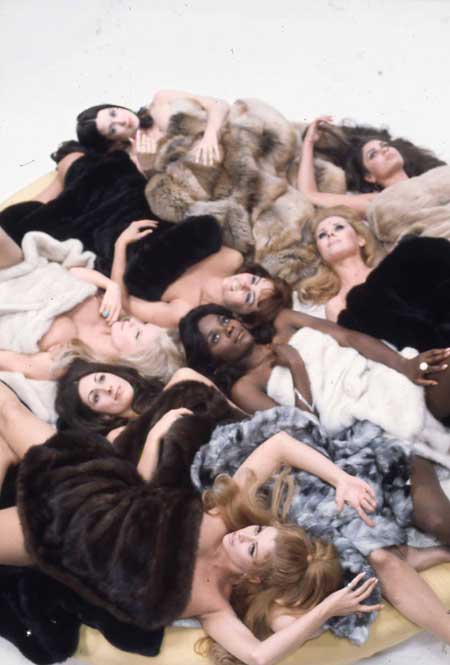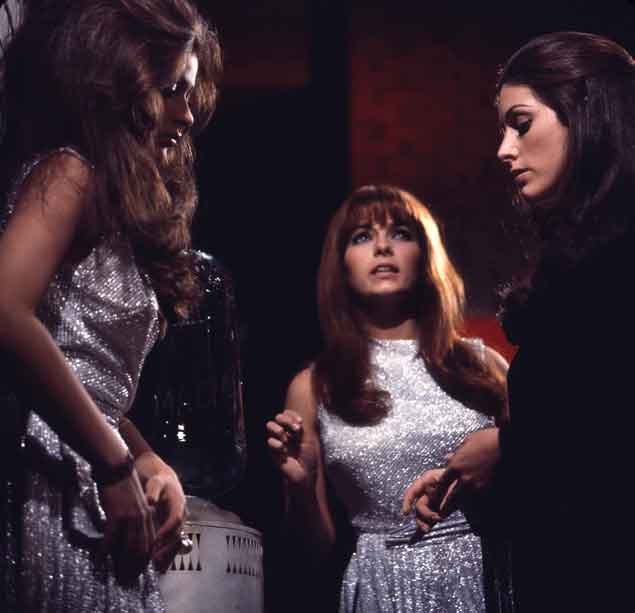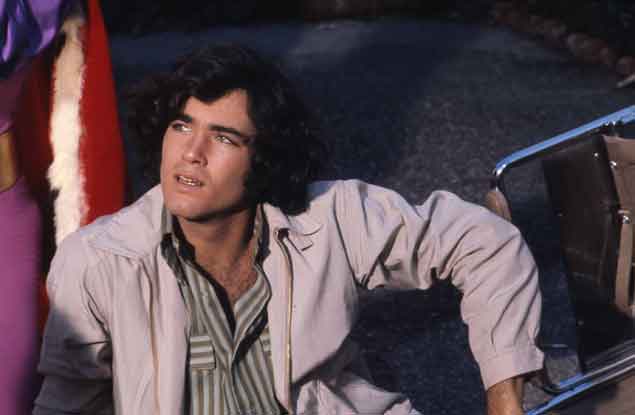Beyond the Valley
of the Dolls By Roger Ebert / 1980
Ebert's Note: "Beyond
the Valley of the Dolls," a movie for which I wrote the
screenplay in 1969, has over the years become a cult film.
Although it would not be appropriate for me to review it or
give it a star rating, I offer the following observations written
for Film Comment magazine on the occasion of the movie's 10th
anniversary in 1980.
Remembered after 10 years, "Beyond
the Valley of the Dolls" seems more and more like a movie
that got made by accident when the lunatics took over the asylum.
At the time Russ
Meyer and I were working on "BVD" I didn't really
understand how unusual the project was. But in hindsight I can
recognize that the conditions of its making were almost miraculous.
An independent X-rated filmmaker and an inexperienced screenwriter
were brought into a major studio and given carte blanche to turn
out a satire of one of the studio's own hits. And "BVC" was
made at a time when the studio's own fortunes were so low that
the movie was seen almost fatalistically, as a gamble that none
of the studio executives really wanted to think about, so that
there was a minimum of supervision (or even cognizance) from
the Front Office.
We wrote the screenplay
in six weeks flat, laughing maniacally from time to time, and
then the movie was made. Whatever its faults or virtues, "
" is an original -- a satire
of Hollywood conventions, genres, situations, dialogue, characters
and success formulas, heavily overlaid with such shocking violence
that some critics didn't know whether the movie "knew" it
was a comedy.
Although Meyer had been signed
to a three-picture deal by 20th Century-Fox, I wonder whether
at some level he didn't suspect that "BVD" would be
his best shot at employing all the resources of a big studio
at the service of his own highly personal vision, his world of
libidinous, simplistic creatures who inhabit a pop universe.
Meyer wanted everything in the screenplay except the kitchen
sink. The movie, he theorized, should simultaneously be a satire,
a serious melodrama, a rock musical, a comedy, a violent exploitation
picture, a skin flick and a moralistic expose (so soon after
the Sharon
Tate murders) of what the opening crawl called "the
oft-times nightmarish world of Show Business."
What was the correct acting style for such a hybrid? Meyer directed
his actors with a poker face, solemnly, discussing the motivations
behind each scene. Some of the actors asked me whether their
dialogue wasn't supposed to be humorous, but Meyer discussed
it so seriously with them that they hesitated to risk offending
him by voicing such a suggestion. The result is that "BVD" has
a curious tone all of its own. There have been movies in which
the actors played straight knowing they were in satires, and
movies which were unintentionally funny because they were so
bad or camp. But the tone of "BVD" comes from actors
directed at right angles to the material. "If the actors
perform as if they know they have funny lines, it won't work," Meyer
said, and he was right.
The movie was inspired only incidentally
by "Valley of the Dolls." Neither Meyer nor I ever
read Jacqueline Susann's book, but we did screen the Mark
Robson film, and we took the same formula: Three young girls
come to Hollywood, find fame and fortune, are threatened by sex,
violence and drugs, and either do or not do win redemption.
The original book was a roman a
clef, and so was "BVD," with an important difference:
We wanted the movie to seem like a fictionalized expose of real
people, but we personally possessed no real information to use
as inspiration for the characters. The character of teenage rock
tycoon Ronnie "Z-Man" Barzell, for example, was supposed
to be "inspired" by Phil Spector -- but neither Meyer
nor I had ever met Spector.
The movie's story was made up as
we went along, which makes subsequent analysis a little tricky.
Not long ago, for example, I was invited up to Syracuse University
to discuss Meyer's work, and the subject of Z-Man came up. (Readers
who have seen "BVD" will know that Z-Man is a rock
Svengali who seems to be a gay man for most of the movie, but
is finally revealed to be a woman in drag.) Some of the questions
at Syracuse dealt with the "meaning" of Z-Man's earlier
scenes, in light of what is later discovered about the character.
But in fact those earlier scenes were written before either Meyer
or I knew Z-Man was a transvestite: that plot development came
on the spur of the moment. So, too, did such inspirations as
quoting a "Citizen
Kane" camera movement from a stage below to a catwalk
above, or the use of the Fox musical fanfare during the beheading
sequence.
They asked at Syracuse if Meyer's
use of the Fox trademark music was a put-down of the studio system.
Meyer's motive was much more basic: By using the music, he hoped
to establish a satiric tone to the scene that would moderate
the effect of the beheading and help protect against an X rating.
In the event, of course, "Beyond
the Valley of the Dolls" was
rated X anyway. There is a story about that. If the movie were
to be rated today, it would probably get an R rating with a few
small cuts. It was a very mild X. That was because Meyer and
the studio were aiming for the R rating. When they didn't get
it, Meyer believed the ratings board had felt obligated to give
the "King of the Nudies" an X rating, lest it seem
to endorse his movie to the Majors.
Because the movie was stuck with
the X, Meyer wanted to re-edit certain scenes in order to include
more nudity (he shot many scenes in both X and R versions). But
the studio, still in the middle of a cash-flow crisis, wanted
to rush the film into release. Meyer still waxes nostalgic for
the "real" X version of BVD, which exists only in his
memory but includes many much steamier scenes starring the movie's
many astonishingly beautiful heroines and villainesses.
The visit to Syracuse was a chance
for me to see BVD again for the first time in a few years. The
movie still seems to play for audiences; it hasn't dated, apart
from the rather old-fashioned narrative quality it had even at
the time of its release. It begins rather slowly, because so
many characters have to be established and such an ungainly plot
has to be set in motion. (The story is such a labyrinthine juggling
act that resolving it took a quadruple murder, a narrative summary,
a triple wedding and an epilogue.) But the last hour has a real
kinetic energy, and the scenes beginning with Z-Man's psychedelic
orgy and ending with his death are, I must say on Meyer's behalf,
as exciting, terrifying and dynamic as any such sequence I can
remember. That stretch of "BVD" is pure cinema, combining
shameless melodrama, highly charged images of violence, sledge-hammer
editing and musical overkill. It works.
And the movie as a whole? I think
of it as an essay on our generic expectations. It's an anthology
of stock situations, characters, dialogue, clichés and
stereotypes, set to music and manipulated to work as exposition
and satire at the same time; it's cause and effect, a wind-up
machine to generate emotions, pure movie without message. The
strange thing about the movie is that it continues to play successfully
to completely different audiences for different reasons. When
Meyer and I were hired a few years later to work on an ill-fated
Sex Pistols movie called "Who Killed Bambi?" we were
both a little nonplussed, I think, to hear Johnny Rotten explain
that he liked "Beyond the Valley of the Dolls" because
it was so true to life.
Kelly McNamara: Dolly Read
Casey Anderson: Cynthia Myers
Petronella Danforth: Marcia McBroom
Harris Allsworth: David Gurian
"Z-Man": John Lazar
Lance Rocke: Michael Blodgett
Ashley St. Ives: Edy
Williams
Roxanne: Erica Gavin
Susan Lake: Phyllis Davis
Baxter Wolfe: Charles Napier
Emerson Thorne: Harrison Page
20th Century Fox Presents A Film Produced And Directed By Russ
Meyer. Screenplay . Running Time: 109 Minutes. Classified
NC-17. |
Beyond
the Valley of the Dolls by Peter Sobczynski
By all rational standards, “Beyond the Valley of the Dolls” should
have been one of the all-time disasters in the history of Hollywood.
For starters, it was originally conceived as a cash-in sequel to
one of the dumbest and crassest films ever made, 1967's “Valley
of the Dolls” (itself based on the equally dumb, crass and
successful Jacqueline Susann best-seller), though the final product
would have absolutely nothing to do with the original. Later, after
attempts at writing a straightforward screenplay (including a couple
of attempts from Susann herself) fell through, someone at the studio
had the idea of hiring Russ Meyer, the fiercely independent skin-flick
auteur who had made a mint with the cheerfully sleazy likes of “The
Immoral Mr. Teas,” “Faster, Pussycat! Kill! Kill!” and “Vixen,” to
make his big-studio debut with the project. To assist him, Meyer
turned around and hired some ink-stained wretch out of Chicago
by the name of Roger Ebert to help him write the screenplay. Somehow,
all these disparate elements managed to come together and the resulting
film remains one of the damndest things ever made–a goofy,
grisly, screw-loose combination of sex, drugs, psychedelic rock
and lurid excess that still has the power to blow minds 35 years
after it first appeared.
Although the idea of attempting to summarize the astoundingly byzantine
plot is a terrifying notion–there are David Lynch films that
are easier to recount–I will try to give newcomers a taste
of what they can expect from “BVD” (as it is affectionately
known). Kelly (Dolly Read), Casey (Cynthia Myers) and Pet (Marcia
McBroom), the members of an all-girl rock trio (imagine the missing
link between Josie and the Pussycats and L7), head out for the
glittery lights of Hollywood so that the band can seek fame and
fortune and Kelly can collect a share of an inheritance from her
long-lost aunt, glamourous fashion designer Susan Lake (Phyllis
Davis). Once they arrive, they are taken under the wing of flashy
music producer Ronnie “Z-Man” Barzell (John LaZar)
and quickly become the toast of the town. Before long, the once-innocent
girls (okay, semi-innocent) are swept up in a wave of drugs, sin
and depravity–Kelly forsakes longtime boyfriend Harris (David
Gurian) for sleazy movie star Lance Rocke (Michael Blodgett) while
fending off the lurid advances of her aunt’s sleazy lawyer
(Duncan McLeod), Casey finds herself the target of seduction by
the sexy lesbian Roxanne (Meyer regular Erica Gavin), Pet finds
love with handsome law student Emerson Thorne (Harrison Page) but
risks it all for a roll in the hay with heavyweight champion Randy
Black (Jim Inglehart) and Harris finds himself in the clutches
of the man-eating hedonist Ashley St. Ives (Edy Williams). All
of these plot threads–and a few that I haven’t mentioned–all
come together in a final act that is so luridly over-the-top that “Grand
Guignol” doesn’t come close to describing it adequately.
Without exaggeration, I can assure you that the finale involves,
among other things, a crippling accident, a miraculous recovery,
a mass murder vaguely reminiscent of the antics of the Manson family,
Nazis, a triple wedding and the shocking discovery that there is
more to Z-Man than meets the eye.
Those of you who have never seen the film before are probably thinking
that there is no possible way that any film could possibly live
up to the expectations created by such a description–I know
I felt that way before I finally got a chance to see it for the
first time. Not only does it live up to those expectations, it
actually manages to exceed them. Instead of allowing himself to
be second-guessed and defanged in the way that so many iconoclastic
directors do when they first attempt to work within the studio
system, Russ Meyer charged in full-speed ahead and came up with
a work that had all the things that made his films unique–a
whiplash editing style, bizarre humor and an approach to erotic
material that manages to suggest a lot while showing comparatively
little (this may be the mildest of all the films tagged with an
NC-17 rating)–with the addition of a glossier style that
fit perfectly with the story he was telling. The screenplay cooked
up by Meyer and Ebert is a hilarious satire of practically every
Hollywood cliché you can think of (even throwing in a weirdo
homage to “Citizen Kane” at one point) which is made
even funnier by the fact that most of the actors seem to believe
that they are in a serious movie. (The exceptions to this are LaZar
and Williams, both of whom start off cranked up to 11 and proceed
to go even further as things progress.) And while one can certainly
laugh at the hilariously outdated fashions and slang (which probably
came across as over-the-top even back in 1970), it isn’t “camp” by
any means–this is a film that belongs in a category all by
itself.
Although a box-office success when it was released, “BVD” has
had a checkered life in the years since–for a while, Fox
seemed embarrassed by the title (along with its even-more lurid
contemporary “Myra Breckenridge”) and it didn’t
get a major VHS release until 1993–but this amazing 2-disc
DVD makes up for all of that with a package that will exceed the
wishes of even the most devoted fans. The first disc features two
commentary tracks, one by Ebert and the other with Dolly Read,
Cynthia Myers, Harrison Page, John LaZar and Erica Gavin. Ebert’s
talk is a fun and breezy history of the creation of the film and
if there is a flaw to it, it is that many of the stories he tells
will be a little familiar to the hard-core buffs. The cast commentary
may not be particularly profound or enlightening but it is fun
to listen to them as they confront their collective past with equal
parts humor and disbelief. The second disc features several short
documentaries that offer a general overview of the film, detailed
looks at specific aspects (such as the music and the sexual material)
and observations on its enduring cult appeal, some of the original
screen tests for the stars, trailers and a few hundred still photos
chronicling every facet of the film (including the Good Parts).
Even if it had been released in a bare-bones version, it would
have been worth it to get a “BVD” DVD but this set
is a happening that will freak everyone out. (Fox is also releasing
the original “Valley of the Dolls” on DVD this week
in an equally overstuffed package–it is amusing enough as
camp but “BVD” beats it like a gong.)
Written by Roger Ebert. Directed by Russ Meyer. Starring
Dolly Read, Cynthia Meyer, Marcia McBroom, John LaZar and Charles
Napier. 1970. 109 minutes. Rated NC-17. A Fox Home Entertainment
release. $29.95. |


